 |
||||||||||||||||||||
| I dislike "Best Sound of Show" attempts for one simple reason. To these ears, there are different flavors of sound, styles of presentation. Some emphasize transparency, a light, fleet sound. Others go for a silken refinement, most often represented by the SET brigade. Others go for resolution and focus. Yet others opt for the visceral adrenaline rush. None of these camps is more right, mo betta than the others. Hence awarding an unequivocal "best" seems folly. Still, in their respective categories, certain rooms stood out over others. Not surprisingly parked in the last category of the alpine go-for-broke plateau, my personal favorite? The Avantgarde Acoustic, Balanced Audio Technology, Cardas Audio, Grand Prix Audio, Running Springs Audio and Spotheim La Luce demo. By Saturday, this über-system had settled in to produce what for this thrill seeker was the emotionally most gripping, dynamically most unrestrained performance, feeling phenomenally "live" and exciting on a grand, real-life scale (hover mouse for photo credits). |
||||||||||||||||||||
 |
||||||||||||||||||||
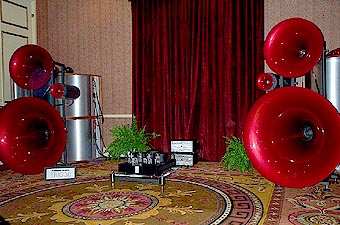 |
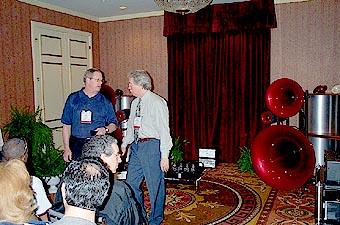 |
|||||||||||||||||||
 |
||||||||||||||||||||
 |
||||||||||||||||||||
 |
||||||||||||||||||||
 |
||||||||||||||||||||
| Bass performance of this full-range setup was contingent on position. Where in the large ball room did you sit/stand? A differential of just one seat could spell profound differences. During the first public day, the principals, on a lark, decided to experiment. They spun the opening cuts of Pink Floyd's crowd pleaser Dark Side of the Moon to enthusiastic response. After playing small-scale ensemble male and female vocals and hitting the usual show-off categories, BAT's Geoff Poor announced the Gran Finale to this controlled, closed-door demo. Were 113-115dB peaks okay with ever'one? During my demo, nobody objected. The subsequent "Bricks in the Wall" had more intelligibility of the background din and vocal fragments, more slam, projection and sheer gut-wrenching impact than anything else at the show - without getting hard or unpleasant like some others attempting same. | ||||||||||||||||||||
 |
||||||||||||||||||||
That was a sign of extremely low loudspeaker distortion, plus the obvious way horns couple transducer radiation to the air differently. These one-track-only SPLs didn't clip ears but translated as a whole-body experience instead. During my turn, the audience broke into unprompted applause, many milled about to ask questions or ogle the monstrously radiant La Luce CS Centoventi turntable, which George Cardas himself had transferred from his personal listening room in Oregon's Bandeon-by-the-sea. (In a double-take, Jeff Joseph brought his smaller La Luce for the parallel Manley/Joseph demo.) As in a few other top rooms (most notably both Kharma/Tenor systems), my favorite resonance control equipment by Grand Prix Audio was part of the action, making it one of the most visible contributors to great sound at HE2003. The $2,800 Rives PARC (Parametric Adaptive Room Correction) room mode equalizer was a close second, appearing here and at least also in the Shunyata, Sim Audio/Talon and Pure Audio exhibits. A two-channel three-band analog device, the optional BARE software - Bass And Room Evaluator -- measures steady-state room frequency response between 20 and 350Hz; time energy and waterfall curves; and plots the psycho-acoustically most benign response curve via 3 channel-specific variables: frequency, Q/width and attenuation of up to 18Hz (PARC provides zero gain and is a notch filter only). All companies using it endorsed its efficacy in combating the usual room boom. Caelin Gabriel of Shunyata Research even demonstrated its must-have virtue bypassing it, then showing me the three frequency bands addressed in his setup: 53Hz, 94Hz and 159.3Hz. If you suffer from audible bass muddification and already know that most room treatments are barely effective below 200Hz, this device should be investigated. The Running Springs Audio powerline conditioners ($1,495 for the 12-outlet, 1,800-watt continuous Ashli, $2,495 for the 20-amp 2,400-watt Danielle) used in this hall also looked extremely worthy of curiosity. To put pen to such statements, one of these units is bound for Arroyo Seco momentarily. After this over-the-top system, close second in the oceanic category of sound reproduction? The Calix Technology/ Edge Electronics/Acoustic Zen room, sporting a similarly charged mien on a smaller near-field scale. |
||||||||||||||||||||
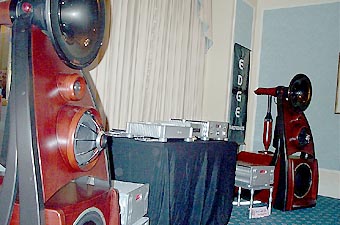 |
 |
|||||||||||||||||||
| With high-power, high-current amplification keeping iron-fisted control, this outboard-crossover, architectural five-driver horn-loaded Signature Phoenix Grand speaker system from Taiwan with its 15-inch dynamic woofer impressed me with its immediacy, wallop and image density. That put a -- very pretty --Halle Berry jinx on the notion that yours truly only likes low-power tube rigs. Unfortunately, it confirmed once more that my ears are bigger than my wallet, too. Seeing how small my ears are ... well, you get the drift (tsunami more like it). Don't despair. For those music lovers divorced from their stock options, my favorite affordable entries to follow down below. Acoustic Zen's Robert Lee was in attendance and prepared to hire me as sales & marketing consultant on the spot. Apparently impressed by the work I had done for Soliloquy, he'd observed the latter's decline in visibility since my demise - um, disappearance. Knowing how tough life in the audio trenches had become, I declined with the very valid argument that my current dream gig at the helm of this small writing venture constituted a severe conflict of interest. I didn't have the heart to tell him that writing about audio rather than selling it was far more to my liking these days. You know, let others pay their dues and sweat the real work. Hey, spin jobs are what marketing guys do best - did he buy it? Looking for a job in High-End audio? Have the proper qualifications to go with it? Contact Acoustic Zen. Selling cables is hard work though. Go ask Shunyata's Grant Samuelson. He's doing a bang-up job and can scare you something fierce. |
||||||||||||||||||||
 |
||||||||||||||||||||
My favorite discoveries on the sane shore of the fiscal river? Gallo Acoustics new flagship at $2,599/pr, Sonic Euphoria's new $1,195 passive autoformer-attenuator preamp and Klaus Bunge's new Odyssey Design Group Khartago ($750) 110-watt stereo amp and matching Etesian ($295) 3-input passive preamp. Let's begin with Anthony Gallo's new marvel - the return of the Nucleus Reference in its 3rd incarnation, fittingly dubbed the Nucleus Reference III. A friend of the poor, Anthony's always gone not for broke but the highest possible bang for the buck. Parked close the front wall, with zero room treatments in sight and good while sane electronics in evidence (Arcam FMJ CDP, Rogue Audio preamp, Spectron digital amp and, if I know Anthony, probably some cheap-ass zip cord), the new Reference rocked. |
||||||||||||||||||||
 |
||||||||||||||||||||
| Retaining the familiar MTM cluster of his Due monitor, albeit with a revised version of the famous CDT tweeter for 300-degree dispersion, 3-50kHz coverage and no crossover above 125Hz, the Reference III adds a side-firing dual voice-coil 10" woofer in an enclosure barely deeper than a pasta pot, the hollow stem of the support structure being used as additional air space. Twin hyperbolic 4-inch carbon fiber midranges load into micro spherical chassis filled, like the woofer chamber, with Gallo's special foam pellets that alter air density to fool the transducers into acting as though venting into larger enclosures. A full-height perforated grill and optional 2 x 240-watt Bass Augmentation Module (BAM) for 22Hz extension complete the picture. This includes 8-ohm impedance, 88dB sensitivity, 350-watt continuous power handling, 47 lbs of heft and dimensions of 35" height, 8" width and 16" depth. The wide-dispersion, ultra-low distortion, super-dynamic tweeter is the piece de resistance here, affording a wide open, ultra spacious sound that remains remarkably focused nonetheless. Availability is expected for the third quarter (don't bug the man before then!) | ||||||||||||||||||||
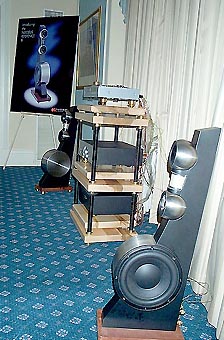 |
||||||||||||||||||||
 |
||||||||||||||||||||
One of the smartest speaker designers around, it was a pleasure to see Anthony Gallo return to the fold which he had so unceremoniously vacated when his Micro speakers first premiered. Bravo, Anthony. Don't let High-End audio get to you again. We need ya. Okay? Best of luck! Stepping down the price ladder, we meet Jeff Hagler of San Diego who decided that high-quality passive without resistors, potentiometers or capacitors in the circuit but top-notch build quality and a fair price was what the world needed in a modern preamp. With 43 steps of precision gain control that, due to the autoformers, increases in current as voltage drops, the PLC Passive Line Controller by Sonic Euphoria sports 6 inputs, 3 outputs and comes with a plethora of super-affordable options: WBT top-line RCAs ($30/pr); Tape output ($40); Black Diamond Racing cones ($45/3); 1-meter captive RCA ($100) and XLR ($120/pr). A fully balanced version of the PLC is available for $1,795, all units are sold direct only. |
||||||||||||||||||||
 |
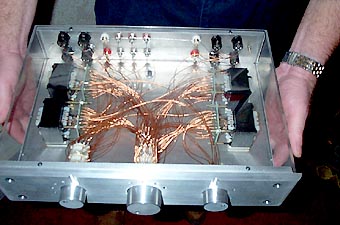 |
|||||||||||||||||||
Honing an aggressively scary edge to the price/performance sweepstakes, Odyssey Design Group introduced the high-current, 60,000uF capacitance, 2Hz to 400kHz ultra wide-band Khartago Class A/AB stereo amp. Measuring 18" x 16" x 4", it's internally wired with Groneberg, exceedingly well put together and faces the discerning eye with a 10mm machined, brushed, anodized and laser-engraved face plate. |
||||||||||||||||||||
The Etesian preamp uses active relay switching, an ultra-linear Alps volume control and adds an HT bypass function. Shorter than the amp by 4 inches, it still weighs in at 18 lbs (the amp is 38). It gets better. Klaus Bunge offers complete systems merely lacking a source component: At $1,500 (with Epiphany monitors) and $2,100 (with Nightingale towers), the pre/power combo is the new duo and Groneberg interconnect and speaker cable is included. At $3,200 (with Nightingale towers) and $4,500 (with Lorelei towers), the pre/power complement is the remote-controlled Tempest/120,000uF Stratos, cables included. Who says good sound has to cost a fortune? The secret here is in the virtual cloning of the German Symphonic Line products, with manufacture shifted to Canada and reps and retailers shot - er, eliminated. If the high-strung Bunge can avoid a heart attack from personal excitement over his accomplishments, the futures for Odyssey seems rosy indeed. |
||||||||||||||||||||
 |
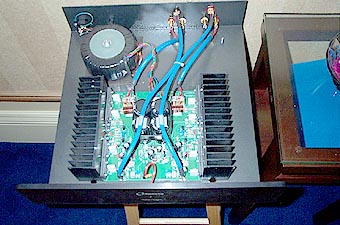 |
|||||||||||||||||||
 |
||||||||||||||||||||
 |
 |
|||||||||||||||||||
 |
||||||||||||||||||||